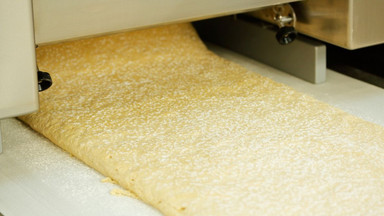Jul 7th 2020
The Benefits of a Dough Sheeter
Dough sheeters use rollers to flatten dough to a consistent thickness. The process presses out gasses, developing gluten (in dough that has gluten) and toughening the dough. One of the top benefits of a dough sheeter is consistency—the results will be uniform, so every cut of dough of the same size takes the same amount of time to bake.
Pizza Crust
Using a dough sheeter to create pizza crust results in a smooth and completely flat dough. The pressing action of the rollers essentially adds another kneading step. This saves time and results in a crisper pizza crust. The wide ribbon of dough the sheeter produces doesn’t have a raised edge, so it is great for covering the entire surface with toppings. Using the sheeter still saves time for pizza that needs a rolled edge—the dough simply must proof again once it is rolled. Then, the pizza can be pressed into the pan or shaped as necessary. Either way, a dough sheeter saves the time of hand-rolling dough.
Dough sheeters can help work extremely tough dough for a thin, cracker-crust pizza. This old-style crust uses thin sheets folded over and re-shaped. The roller provides the muscle for working with this kind of tough dough to make it thin enough.
Not Just for Pizza
Dough sheeters are adjustable to produce dough of various thicknesses. The rollers act as kneaders, which saves time, and the adjustments available on a commercial dough roller make it possible to create pastries and even roll fondant for icing cakes. Bakers can use dough sheeters to create layers of dough to laminate atop each other. The benefits of dough sheeters include reducing the time and labor that goes into making puff pastry. Even sticky, wet dough for ciabatta can go through a sheeter.
Preparing dough using a sheeter frees up kitchen and bakery staff to attend to other tasks. It also can standardize baking processes because using dough from a sheeter removes any guesswork about how long to bake it. Every item from the same sheet of dough will have the same thickness, meaning they all require the same baking time.
Of course, different ingredients call for different methods. Experienced bakers will decide whether to use additives to reduce shrinkage when the gluten development causes “snap back” after forming the dough, or to use cold- or hot-pressing methods to vary the internal cell structure and uniformity of the baked product.

